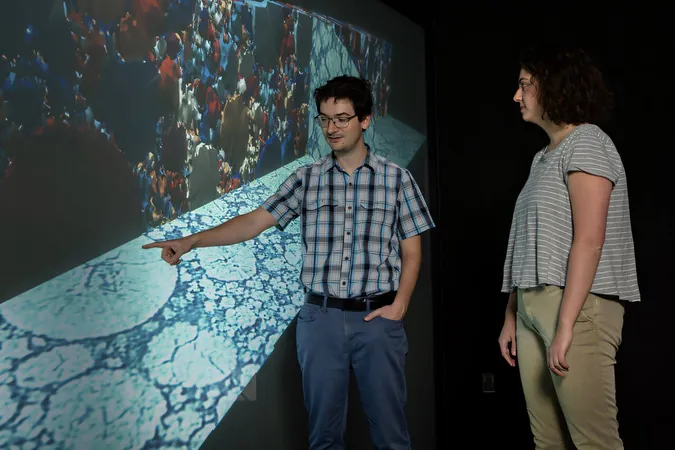
Revealing the Hidden Threats to Battery Power: Advanced Nano-CT Imaging Uncovers Internal Damage
2025-06-16
Author: Li
The Battle for Battery Resources
Lithium-ion batteries are the backbone of modern energy storage, relying on precious minerals like lithium, nickel, cobalt, manganese, and graphite. Yet, as demand skyrockets across the U.S., sourcing these vital materials becomes increasingly precarious, exposing our energy infrastructure to unpredictable global markets. Currently, China oversees a staggering 60% to 90% of the world’s processing for these minerals, according to a recent U.S. Department of Energy report.
Recycling: The Answer to Supply Chain Woes?
While the direct recycling of battery cathodes presents a viable path to bolster domestic supply chains and prolong the life of essential materials, conventional recycling practices prove to be both costly and energy-heavy—essentially dismantling batteries to their core elements before reassembling them from the ground up.
A Revolutionary Approach to Battery Recycling
Enter researchers from the National Renewable Energy Laboratory (NREL), who are redefining direct recycling by attempting to preserve and refurbish existing battery components. However, there’s a catch: not all recycled batteries yield the same quality. Hidden microscopic damage accumulates over time, degrading some batteries' performance. Ensuring the recovery of high-quality materials is crucial to meeting consumer expectations.
Nano-CT Imaging: A Peek Inside the Battery's Soul
NREL scientists are harnessing the power of X-ray nanoscale computed tomography (nano-CT) imaging to unearth these concealed defects in batteries nearing the end of their life cycle. Utilizing advanced technology capable of achieving a remarkable 50-nanometer resolution—an ability usually reserved for high-energy synchrotron X-ray facilities—this research, published in *Advanced Energy Materials*, could change the recycling game.
This groundbreaking imaging technique allows for a non-destructive examination of battery materials, providing real-time insights into how their internal structure evolves during charge cycles.
Unlocking the Mystery of Performance Degradation
"This in-house, high-resolution imaging enables us to scrutinize specific degradation types present in end-of-life battery materials," explains Donal Finegan, a senior energy storage scientist at NREL. Alongside advanced artificial intelligence and other microscopy tools, nano-CT can help identify obstacles in direct recycling. The goal? To design methods that recover and refurbish high-quality materials, enhancing battery efficiency.
Tiny Defects, Major Consequences
In the early stages of their research, scientists discovered that while end-of-life battery cells exhibited energy capacities akin to brand-new cells, their charging speeds were severely compromised. Melissa Popeil, an NREL energy storage doctoral researcher, noted, "We were startled to find that the primary degradation factor was morphological damage, specifically particle cracking within the material's microstructure."
The scope of the project expanded beyond simple performance measures to an exhaustive analysis of battery cell capacity, composition, and more, focusing on commercial cells subjected to real-world usage. Using nano-CT in tandem with NREL's Microstructure Analysis Toolbox (MATBOX), researchers meticulously identified and quantified damage types within each cell.
Facing the Challenge of Cracks
As efforts to enhance recycling methodologies progress, addressing the significant cracks in battery cathode materials is paramount. Luckily, NREL researchers are equipped to tackle this problem.
"Now that we’ve pinpointed the scope of cracking, we’re exploring innovative strategies to process end-of-life materials and repair the damage," states Popeil. "By focusing on the mechanical changes within the material, we can streamline recovery methods and minimize the need for extensive chemical processing."

 Brasil (PT)
Brasil (PT)
 Canada (EN)
Canada (EN)
 Chile (ES)
Chile (ES)
 Česko (CS)
Česko (CS)
 대한민국 (KO)
대한민국 (KO)
 España (ES)
España (ES)
 France (FR)
France (FR)
 Hong Kong (EN)
Hong Kong (EN)
 Italia (IT)
Italia (IT)
 日本 (JA)
日本 (JA)
 Magyarország (HU)
Magyarország (HU)
 Norge (NO)
Norge (NO)
 Polska (PL)
Polska (PL)
 Schweiz (DE)
Schweiz (DE)
 Singapore (EN)
Singapore (EN)
 Sverige (SV)
Sverige (SV)
 Suomi (FI)
Suomi (FI)
 Türkiye (TR)
Türkiye (TR)
 الإمارات العربية المتحدة (AR)
الإمارات العربية المتحدة (AR)